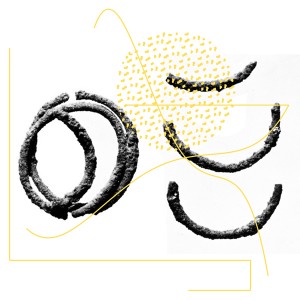The music of Jar Moff is often lumped in under plunderphonics — a term originally coined by collagist composer John Oswald in 1985. Typically, the term is now used to refer to any music that is made entirely from preexisting audio recordings, whereas in its original usage, plunderphonics referred to sound-collages that framed samples in much the way pop art recontextualised iconic imagery. The intention was to relate recognisable musical quotations from the past with listeners and idioms of the present, thereby providing new conceptual frameworks to earlier forms. In this respect, Financial Glam is not plunderphonics. While the early examples of this music were largely seamed, angular, and conceptual, Financial Glam is seamless, organic and experiential. Jar Moff’s latest album does not merely recount an experience, it constructs one.
In some respect, Financial Glam is a soundtrack to a dystopian present. As a resident of Athens, Greece, with floor seats to ground zero, Jar Moff has found himself in a unique position to score the bleakness of modern collapse. The artist has suggested that his new work – as with sister album Commercial Mouth – reflects the economic turmoil of his hometown surroundings. Although this meaning is hardly obvious or explicit, if we follow the concept then Financial Glam can be taken as an incisive commentary — a searing eschatological statement on economic brutality. And through the album’s unsettling immersion and grainy detail, the listener becomes something of a participant rather than merely a spectator to Athens’ very real, present day hell.
As both a visual and musical artist, Jar Moff’s approach to composition is not dissimilar to Burroughs’ infamous cut up technique. With his latest audio product, a large archive (more than 220 samples) of musical fragments were collected, cut, colored, spliced and repurposed to manifest a multilayered montage, one whose source material becomes unrecognisable, masked to the point of camouflage. The sound-design is astonishingly dense as a result, an extricable weave of analog, digital, organic, and synthesised sounds whose effect has an unusual physicality to it, making Financial Glam both strongly visual and extraordinarily immediate. As a consequence, the album’s two pieces both seem to progress through tangible space, locked in perpetual motion, busy decaying or evolving, always in the midst of crescendo or diminuendo. The indistinguishable entanglement of the acoustic and the electronic, the hands-on methodology, and the corresponding tactility firmly, if indirectly, place Financial Glam in the radical traditions of music concrète and electro-acoustic music.
In an interview with the Quietus last month, Moff touched on this relationship, citing 20th century composers including Ligeti, Penderecki and Boulez as influences on Financial Glam. This does certainly seem to be the case. The title track builds and unravels with a panicked intensity and flickering cacophony reminiscent of Penderecki’s early work, while slow lurching Ligeti-like blocks persistently engulf the backdrop. And opener ‘Kresentosiagona’ juxtaposes atonal bursts with airy silences in a manner suggestive of Schaeffer’s sound organisation, drawing out an immensely dramatic geography where sudden upheavals await the listener at each new bend. In addition, from the opening static to the closing industrial exhale, Financial Glam maintains a rich multidimensionality that owes much to Varese’s spatial conception of music. In virtue of their toothy, avant-garde structures, and in line with the artist’s apparent intention, currents of dread, paranoia, and claustrophobia snake throughout these tracks — a steady stream of cerebral taunts that gains its power from Moff’s unnerving but masterful arrangement.
In spite of the parallels to the works of the aforementioned composers, Financial Glam is most similar – in fact, strikingly so – to the maximalist music concrète of Paul Dolden, specifically ‘Dancing On The Walls Of Jericho’ from 1994’s L’ivresse de la Vitesse. Not only do the two share aesthetic characteristics – free jazz flares, sheets of white noise, atonal clusters – but they both represent collaged assemblages comprised from literally hundreds of previously recorded fragments: in Dolden’s case, original compositional chunks reworked; in Moff’s case, heavily transformed micro-samples. Financial Glam and ‘Dancing…’ even plot congruent trajectories: buttressing needling fragility with muscled discord, while compressing and decompressing in remarkably similar fashions.
Financial Glam sees Jar Moff improve upon his already impressive template, crafting a more intricate, sensually rich and accomplished album. Despite unabashedly riding on the shoulders of 20th century giants, Moff has produced a work that can stand proud in the colossal shadow of its esteemed forebears. Through careful surgery and discerning restraint, this fresh-faced auteur has put together one of the most intricate and rewarding examples of collage music in recent memory. In no uncertain terms, Financial Glam is an exceptional achievement.


